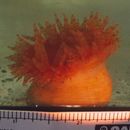Habitat
provided by Invertebrates of the Salish Sea
In the San Juan channel specimens are often captured from sand/gravel bottoms at about 80-100 m depths. They usually come up not attached to anything, though they will readily attach to a solid object in an aquarium. Perhaps this is because they have a swimming response to predators.
- license
- cc-by-nc-sa
- copyright
- Rosario Beach Marine Laboratory
Distribution
provided by Invertebrates of the Salish Sea
Geographical Range: Web sources indicate that it can be found at least in Alaska, British Columbia, and Washington State.
- license
- cc-by-nc-sa
- copyright
- Rosario Beach Marine Laboratory
Comprehensive Description
provided by Invertebrates of the Salish Sea
This subtidal anemone has no acontia, no tubercles on the column wall, usually a cream or orange color, tentacles orange and sometimes banded but with no white spots at their bases. The column is often more than 5 cm high and can stretch to much higher than it is wide. Sometimes the anemone has darker orange or red blotches or streaks. The anemone has at least 160 tentacles in individuals of over 5 cm column height.
- license
- cc-by-nc-sa
- copyright
- Rosario Beach Marine Laboratory
Look Alikes
provided by Invertebrates of the Salish Sea
How to Distinguish from Similar Species: Stomphia coccinea has a whitish column with red or orange-red streaks, is not usually more than 3 cm high, and usually is found on horse mussel shells. Stomphia sp. has less than 130 tentacles on individuals 5 cm or more tall, and its color is a uniform reddish beige.
- license
- cc-by-nc-sa
- copyright
- Rosario Beach Marine Laboratory
Comprehensive Description
provided by Invertebrates of the Salish Sea
Biology/Natural History: Little is known. This is a recently described species. The spincter of Stomphia species in general is strong enough that the upper part of the body can cover the tentacles. This species, as well as a relative Stomphia coccinea, are known to detach from the bottom and swim away from predators such as the leather star, Dermasterias imbricata. S. coccinea is found in northern boreal waters of the Atlantic and Pacific. Another relative, S. selaginella, inhabits McMurdo Sound in Antarctica. On one web site, the BBC reports on S. didemon: "When approached by a predatory leather star, this anemone, Stomphia didemon, became highly agitated. It elongated and swayed from side to side. Then, bending low, it brushed its tentacles over the leather star. Finally, this normally sedentary animal inflated a muscular cone at its base to lever itself free from its moorings and danced away in the water column." The species is said to eat small crustaceans.
- license
- cc-by-nc-sa
- copyright
- Rosario Beach Marine Laboratory
Habitat
provided by Invertebrates of the Salish Sea
Depth Range: The Monterey Bay Aquarium reports that this species lives from 60-180 m depth
- license
- cc-by-nc-sa
- copyright
- Rosario Beach Marine Laboratory
Habitat
provided by World Register of Marine Species
Known from seamounts and knolls
Stocks, K. 2009. Seamounts Online: an online information system for seamount biology. Version 2009-1. World Wide Web electronic publication.
- license
- cc-by-4.0
- copyright
- WoRMS Editorial Board

